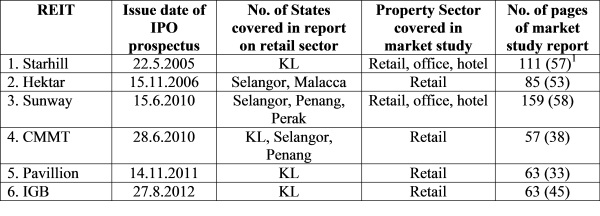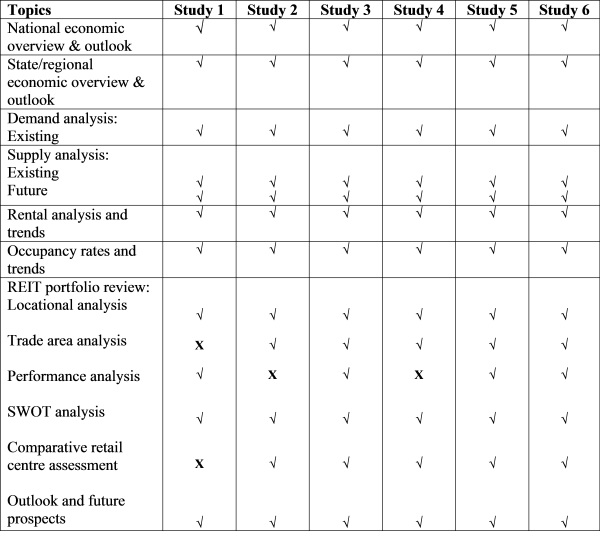Article of the Month -
February 2014
|
Retail Market Studies for the Capital Market:
Form versus Substance
Kien Hwa TING, Malaysia
1) This paper is a Malaysian
Peer Review paper, which will be presented at FIG Congress 2014 16-21
June, in Kuala Lumpur, Malaysia. We are pleased to share this Peer
Review paper with you already now prior the congress to highlight one of
the topics - real estate - covered at the congress. On the 19 and 20
June the Board of Valuers, Appraisers and Estate Agents Malaysia has
been invited to participate in the Congress. and together with FIG
Commission 9 and 10 special sessions on valuation and estate
management are being prepared i.e. the launch of the
International Property Measurement Standards (IPMS). Mr.
See Lian ONG, Chair Elect of FIG Commission 10, is furthermore
facilitating a high-level session on Building Information Management,
BIM.
Key words: real estate investment trusts, initial public
offering, retail market study
SUMMARY
The supply and demand condition of the property
market and the attractiveness of the property portfolios are among the
key factors that investors evaluate before deciding to invest in the
initial public offerings of real estate investment trusts (REITs). To
meet this information need for decision-making, a real estate market
study report is often provided within the prospectus for the purpose of
initial public offering (IPO) and listing on the stock exchange.
This paper examines whether these reports meet the
property market information requirements of REIT investors by examining
retail market study reports found in the REIT IPO prospectuses of Bursa
Malaysia for the 2005 to 2013 period.
The analysis of the retail market study reports are
based on criteria derived from literature review on the criticisms of
real estate market studies. Content analysis using the criteria is
applied to examine whether there are weaknesses in the retail market
studies. The analysis found that the general headings and contents of
these retail market studies are generally the same. However a detailed
content analysis reveals that there are weaknesses in the areas of data
analysis and analytical techniques of these retail market studies.
Hence the generally broad headings (i.e. form) found
in the content of a market study may not necessarily provide enough
information/data (i.e. substance) to assist investors in making their
investment decisions.
1. INTRODUCTION
Each REIT initial public offering (IPO) requires a
prospectus to be filed with the Securities Commission and the Stock
Exchange. The prospectus provides details about the REIT investment
offering for sale to the public. A prospectus will contain the facts
that an investor needs to make an informed investment decision. Apart
from the information on the offeror, the properties, the managers, the
trustees, the trust deed etc other important information such as
valuation certificates, proforma balance sheet, profit forecast and
taxation are provided in the appendix of the prospectus.
The supply and demand condition of the property
market and the attractiveness of the property portfolios are among the
key factors that investors evaluate before deciding to invest in the
initial public offerings of real estate investment trusts (REITs). A
real estate market study report is often provided within the prospectus
for the purpose of initial public offering (IPO) and listing on the
stock exchange to meet this information need.
This real estate market study report is a new form of
market study that fulfills the needs of investors and is different from
the traditional market studies that are conducted on new property
development. This paper will examine whether these reports/studies meet
the investment requirements of the REIT investors.
2. REAL ESTATE MARKET STUDY IN THE CAPITAL MARKET
CONTEXT
Market studies are conducted to cover the following
property development and investment situations (Maliza 1992):
-
A use in search of a site (use given, site
unknown)
The market study attempts to identify and select the best site for
the identified use for maximum profit and growth.
-
A site in search of a use (use unknown, site
given)
The study attempts to determine the most fitting and probable use by
studying and comparing legal, physical, market and financial aspects
of alternative uses.
-
Market and financial feasibility are carried for
an identified scheme (use given, site
given)
The study determines the market and financial feasibility of the
proposed project.
-
Capital in search of investment (use known, site
unknown).
A real estate market study analyses the general
market demand for a single or multiple types of properties at a
particular location. Generally real estate market studies are conducted
as part of the development appraisal process (Miles et. al, 2007).
However real estate market studies for the REIT IPOs of the capital
market are for investment appraisal purposes.
In the context of market study for the capital
market, a market study is concerned with the determinants of investment
profitability and its sustainability e.g. population, households,
employment and income etc. Market study is the identification and study
of the market for a particular development/investment. The market study
specifically relates market conditions to the property under evaluation.
It must show how the interaction of supply and demand affects the
feasibility or attractiveness of the development/investment. The study
is used to determine whether there is market support for an existing
property or properties in a portfolio in the foreseeable future (Geltner
et, al, 2013).
An existing retail centre is deemed enjoying maximum
productivity only after an appropriate level of market support has been
demonstrated to exist for that use. In-depth market studies go much
further in specifying the character of that support. Such studies may
determine key positioning strategies, provide estimates on the market
share and absorption rate etc. (Fanning, 2005).
The techniques and procedures of market studies are
getting sophisticated. Market studies can be developed into elaborate
analyses. Fanning (2005) suggests various levels of market analysis that
reflect a spectrum of procedure, methods and techniques.
Myers and Beck (1994) has proposed a ‘four-square
design’ approach to take into account of the present-future and
macro-micro dimensions to conduct a comprehensive market study. A good
market study should take into account of present and future market
conditions and also the macro and micro aspects of the property market.
The objectives of providing a real estate market
study in the prospectus are to meet the following objectives:
-
To provide an overview of the economy and retail
property market,
-
To review the current retail market supply and
demand
-
To highlight key drivers and challenges of retail
market
-
To provide commentary of the retail portfolio of
REITs
-
To conclude on market trend and prospect.
2.1 Guidelines for market study
Real estate professional bodies often provide
guidance to its professional members in carrying out various
professional tasks which covers valuation, ethics and market studies.
In US, a position paper on market analysis in the
appraisal process was adopted by the Joint Valuation/Research
Subcommittees of the National Council of Real Estate Investment
Fiduciaries (NCREIF) in 1995. This was released in an article by Wincott
and Mueller (1995) in The Appraisal Journal. An update of the position
paper was released by NCREIF Valuation Committee on 21 May 2012 (NCREIF,
2012).
In Malaysia, upon the aftermath of the Asian
Financial Crisis, the Bank Negara has recommended to provide property
market studies to support lending to the property sector. A guideline
known as “Market and Feasibility Study Guidelines for Property Projects
or Property Investments” is prepared by The Association of Valuers and
Property Consultants in Private Practice Malaysia (PEPS) in 2001.
The guidelines are prepared in response to the
National Economic Recovery Plan report of August 1998 that bank lending
should be based on merits of the case and supported by detailed market
and feasibility studies.
However the PEPS guidelines to market study cover
merely two pages and all within eleven bullet points. The guidelines did
not provide sufficient details on the content, components and scope of a
good market study. Despite the lack of details in the guidelines,
property consultants had nevertheless continued to prepare market study
reports over the years.
The market study reports found in REIT IPO
prospectuses of Bursa Malaysia provide a research opportunity to examine
the adequacies of these market studies, which are publicly available, in
providing the necessary information for potential REIT investors in
their investment decision making.
3. RESEARCH METHODOLOGY AND DATA
A literature review is carried out to find out the
weaknesses of real estate market studies. Ting (2007) has summarized the
criticisms of market studies under four major stages in carrying out a
market study i.e. data collection, data analysis, analytical techniques
and evaluation. These four major stages are adopted to facilitate a
systematic analysis of the content of a real estate market study report.
The technique of content analysis is applied to
examine the contents of market study report found in the REIT IPO
prospectuses for the 2005 to 2013 period. As the retail market is a more
complex property sector that requires detailed analysis, only the market
study reports that covered the retail market are analysed for this
research. To aid content analysis, words, sentences, paragraphs, tables
and figures relating to retail market prospects are used to examine the
adequacy of the retail market studies whether they satisfy the
objectives of these reports.
To examine the ‘form’ aspect of the retail market
studies, major topics/headings of these reports are collected and to be
evaluated against the market study reports.
To examine the ‘substance’ of these studies, the
strengths and weaknesses of these studies are evaluated against the list
of criticisms by Ting (2007).
Out of the 15 prospectuses issued during the study
period, only six contain retail market study reports (refer Table 1).
Table 1: Selected REIT prospectuses for content
analysis

Note: 1 – The figures in bracket represent the number of pages dedicated
on retail property market and retail centre analyses.
4. ANALYSIS
4.1 Adequacy of general contents of retail market
reports – the ‘form’ aspect
For analysis, the respective market study reports are
coded and arranged randomly to avoid possible identification of the
property consultancy firms that prepare the reports. Table 2 shows the
results of the analysis.
Table 2: Analysis of general contents of retail
market studies in REIT prospectuses

Note : √ - denotes available; X - denotes not available
From Table 2, we can conclude that the form and the
general contents of the retail market studies are generally the same.
But some aspects of retail market analysis are not covered:
- Trade area analysis
- Performance analysis
- Comparative retail centre assessment
The market studies concerned did not provide any form
of coverage in these areas.
4.2 Adequacies of retail market information for
investment decision making – the ‘substance’ aspect
A retail market study that concludes that there is
good prospect in investing in the REITs should contain analyses and
evaluations that are supported by facts and figures. Table 3 examine and
evaluate whether there are any weaknesses in the retail market studies.
Table 3: Criticisms on retail market studies for REIT
IPOs

Note : √ - denotes weaknesses found in report
Table 3 shows there are distinctive weaknesses in the
retail market studies at two levels i.e. individual studies and common
weaknesses among studies.
At individual report level, two of the reports have
significant weaknesses and the balance four are well prepared.
The common weaknesses among the market studies are
(a) unspecified assumptions (b) lack of future demand projections; and
(c) no capture rate.
Examples of unspecified assumptions are:
-
For the primary and secondary trade areas,
distance and travel time are not specified
-
The primary and secondary trade area are circular
in shape,
-
The existing demand factors are assumed to extend
into the future.
Facts and figures on existing and future supply are
usually provided. Existing supply and demand situations are often
analysed using occupancy rate. However there are no projections provided
for future demand. With the lack of analysis between future supply and
demand, the conclusion made on the future prospects of the shopping
centres in the report is questionable.
The capture rate of each shopping centre is not
specified in the studies. It is assumed to remain constant and is not
affected by new shopping centres coming into operations and within the
trade area. This omission may seriously affect the reliability of the
conclusions of the reports.
5. CONCLUSION
The supply and demand condition of the property
market and the attractiveness of the property portfolios are among the
key factors that investors evaluate before deciding to invest in the
initial public offerings of real estate investment trusts (REITs). To
meet this information need, a real estate market study report is often
provided within the REIT prospectus for the purpose of initial public
offering (IPO) and listing on the stock exchange.
Content analysis using the criteria is applied to
examine whether there are weaknesses in the retail market studies. The
analysis found that the general headings and contents of these retail
market studies are generally the same. However a detailed content
analysis reveals that there are weaknesses in the areas of data analysis
and analytical techniques of these retail market studies.
Hence the generally broad headings (i.e. form) found
in the content of a market study may not necessarily provide enough
information/data (i.e. substance) to assist investors in making their
investment decisions.
In conclusion, the retail market studies found in
REIT IPO prospectuses need to be read in detailed to ensure the
conclusions made are well founded and based on proper analysis of facts
and figures. Before making any investment decisions, a critical reading
of the reports particularly the implicit assumptions made will help
investors to conclude whether there is any sustainable prospect in the
shopping centres owned by the REITs.
REFERENCES
Association of Valuers and Property Consultants in
Private Practice Malaysia. 2001. Market and Feasibility Study Guidelines
for Property Projects or Property Investments PEPS
Babbie, Earl. 2013. Social research counts,
Wadsworth, Cengage Learning
Brett, D. L. and Schmitz, A. 2009. Real estate market
analysis: methods and case studies. 2ed. Urban Land Institute,
Washington, D. C.
Fanning, S. F. 2005. Market analysis for real estate:
concepts and applications in valuation and highest and best use,
Appraisal Institute, Chicago
Fanning, S. F. and Jody Winslow. 1988. Guidelines for
Defining the Scope of Market Analysis in Appraisal Assignments The
Appraisal Journal October
Geltner, D. M., Miller, N., Clayton, J. and
Eichholtz, P. 2013. Commercial real estate, South Western Educational
Publishing
Malizia, E. 1992. A framework for real estate
feasibility research Journal of Property Valuation and Investment,
10(3), 640-645
Miles, Mike E., Berens, G. L., Eppli, M J and Weiss,
M. A. 2007. Real estate development: Principles and process, 4 ed. Urban
Land Institute, Washington, D. C.,
Myers, Dowell and Beck, Kenneth. 1994. A Four-square
Design for Relating the Two Essential Dimensions of Real Estate Market
Studies in DeLislie, J R & Sa-Aadu J ed. Appraisal, Market Analysis &
Public Policy in Real Estate, Real Estate Research Issues Vol.1 Kluwer
Academic Publishers
NCREIF. 2012. Market analysis in the appraisal
process, Valuation Committee Position Paper
Ting, Kien Hwa. 2007. A review of criticisms on real
estate market studies, 23rd American Real Estate Society Conference, San
Francisco, USA
Wincott, D. R. and Mueller, G. R. 1995. Market
analysis in the appraisal Process The Appraisal Journal, January, 27 -
32
CONTACTS
Professor Sr Dr. Kien Hwa TING
Universiti Teknologi MARA
Centre for Real Estate Research (COREResearch)
Faculty of Architecture, Planning & Surveying,
40450 Shah Alam, Selangor
MALAYSIA
Tel. +6035544 4217
Fax + 6035544 4353
Email:
tingkien@salam.uitm.edu.my,
tingkienhwa@yahoo.com
Web site: www.uitm.edu.my
BIOGRAPHICAL NOTE
Professor Sr Dr. Kien Hwa TING, Ph.D.(Finance),
FRICS, FRISM is Head of Centre for Real Estate Research (COREResearch),
Universiti Teknologi MARA, Malaysia.
Prof. Dr. Ting is an Academic Member of Asia Public
Real Estate Association (APREA), a Board member of the Pacific Rim Real
Estate Society, RICS Malaysia Board member, Council member of the Royal
Institution of Surveyors Malaysia and a member of the NAPREC Expert
Panel (INSPEN). In August 2013, Prof. Dr. Ting has been appointed a
member of the Standards Setting Committee to develop a global standard
known as International Property Measurement Standards (IPMS) for
measuring buildings.
Prof. Dr Ting is currently the Editor of The
Malaysian Surveyor and International Surveying Research Journal of Royal
Institution of Surveyors Malaysia. He is also an Editorial Board member
of Pacific Rim Property Research Journal, Journal of Real Estate
Literature and Journal of Corporate Real Estate.
 |



























